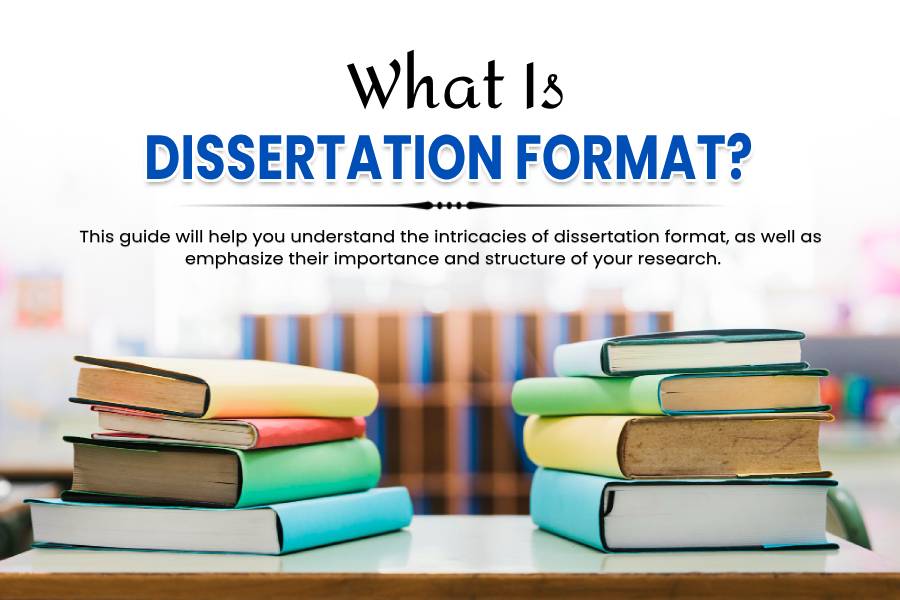Table of Content
What is a Dissertation Format?
Dissertations, the culmination of years of academic pursuit, are not just comprehensive research projects; they represent a scholar’s mastery of their field. In this academic journey, understanding the nuances of dissertation format is paramount. This guide endeavors to unravel the complexity surrounding dissertation format, emphasizing their significance in ensuring the clarity and comprehensibility of your research.
I. Understanding Dissertation Format
A. Definition of Dissertation Format:
At its core, a dissertation format is the skeleton on which your research is structured. It provides a clear roadmap for your readers, ensuring that your ideas flow logically and coherently. By adhering to specific formatting guidelines, scholars enhance the readability of their work, making it accessible to a broader audience.
B. Formatting Requirements:
The title page serves as the face of your dissertation. It encapsulates vital details like the dissertation’s title, your name, institutional affiliation, and submission date. Always be cognizant of any additional requirements stipulated by your university or department; these nuances can be crucial.
Abstracts, succinct summaries of your research, distill your entire dissertation into a few hundred words. They encapsulate your objectives, methodologies, findings, and implications. Crafting a precise and compelling abstract is an art, and its brevity should not compromise the depth of your research.
The table of contents, akin to a roadmap, guides your readers through the labyrinth of your dissertation. Accurate page numbering ensures seamless navigation, underscoring the importance of meticulousness.
In the introduction, your problem statement, research questions, and a brief project overview provide context. Justifying your study’s significance lays the groundwork for the entire dissertation, making the introduction a pivotal section.
II. Structural Elements of a Dissertation
A. Chapters and Sections:
The literature review, akin to the heart of your dissertation format, critically analyzes existing research. It should synthesize information seamlessly, showcasing your expertise on the topic.
Methodology chapters describe your research design, methods, and analyses. Clarity and justification of your chosen methods are key. Present your findings coherently, utilizing tables, graphs, or diagrams to enhance understanding. Your analysis should be thorough, exploring implications and potential future research avenues.
Conclusions should be logical extensions of your findings, answering the core questions posed. Remember, your dissertation is not just an academic exercise; it should offer tangible recommendations for real-world applications.
The Main Structure of a Dissertation
The format of a dissertation typically follows a specific structure to ensure clarity, coherence, and consistency in academic writing. While specific guidelines may vary based on the institution and academic discipline, a standard dissertation format often includes the following sections:
Title Page:
- Title of the dissertation
- Author’s name
- Institutional affiliation
- Submission date
Abstract:
A concise summary of the research, including objectives, methodologies, findings, and implications
Usually limited to 150-300 words
Table of Contents:
List of chapters, sections, and subsections with corresponding page numbers for easy navigation
Introduction:
- Problem statement
- Research questions or hypotheses
- Justification for the study
- Brief overview of the research project
Literature Review:
Critical analysis of existing research and theories relevant to the topic
Synthesis of literature to establish the research gap
Methodology:
Now this is the interesting part,
In this section, you outline the blueprint of your research. It begins with a clear description of your research design, which specifies how you plan to investigate your research questions or hypotheses. You blend into the details of your data collection methods, explaining the techniques and tools you used to gather information. Additionally, you provide an in-depth explanation of your data analysis techniques, elucidating how you processed and interpreted the collected data. Crucially, you justify your chosen methods, explaining why they are the most suitable for your research objectives. This section ensures transparency, allowing readers to understand the framework guiding your study.
- Description of research design
- Details of data collection methods
- Explanation of data analysis techniques
- Justification for chosen methods
Findings and Analysis:
This segment is the heart of your dissertation, where you discover your research outcomes. You present your data in a visually engaging manner, often utilizing tables, graphs, or diagrams to enhance clarity. Beyond mere presentation, you conduct a comprehensive analysis, scrutinizing the data to identify patterns, trends, or significant findings.
But, your analysis goes beyond the surface, following through into the data, providing readers with a deep understanding of your research results. Importantly, you discuss the implications of these findings, exploring their relevance and potential impact on the field of study. This section not only showcases your research prowess but also demonstrates your ability to draw meaningful conclusions from raw data, making your dissertation a valuable contribution to your academic domain.
- Presentation of research data using tables, graphs, or diagrams
- Comprehensive analysis of the data
- Discussion of implications of the findings
Conclusion and Recommendations:
- Summary of key findings
- Addressing research questions or hypotheses
- Suggestions for future research
- Practical recommendations based on the research outcomes
Citations and References:
- Proper citation of all sources used in the dissertation
- Consistent use of a specific citation style (e.g., APA, MLA, Harvard)
Appendices:
- Additional materials such as surveys, questionnaires, or raw data
- Supplementary information supporting the research
- Formatting and Presentation:
- Consistent font style and size
- Clear headings and subheadings to organize content
- Proper margins and spacing
- Thorough proofreading and editing for clarity and coherence
It’s important to note that specific requirements may vary, so students should consult their institution’s guidelines and their advisor for detailed instructions on formatting their dissertations.

Guidelines for Writing a Dissertation Format
A. Citations and References:
Proper citation is the bedrock of academic integrity. Be it APA, MLA, or Harvard style, consistency is key. Cite every source meticulously, acknowledging the intellectual debts you incur along your research journey.
B. Appendices:
Appendices are treasure troves of supplementary information. Whether it’s raw data, surveys, or additional resources, they enrich your dissertation. Organize them clearly, ensuring they enhance, not clutter, your work.
C. Formatting and Presentation:
In the world of academia, presentation matters. Consistent fonts, appropriate headings, and meticulous proofreading elevate your work. Clear formatting underscores your attention to detail, reflecting your dedication to your craft.
Embarking on the dissertation journey can be daunting, but mastering its format is a significant step toward success. In this guide, we’ve demystified the intricate labyrinth of dissertation format, emphasizing their pivotal role in communicating your research effectively.
As you dive into your research, remember the significance of adhering to prescribed formats. They are not constraints but tools, shaping your ideas into a coherent narrative. Embrace the challenge, consult institutional guidelines, and seek guidance when needed. Your dissertation is not just an academic requirement; it’s a testament to your expertise, a legacy of your intellectual prowess. Craft it with care, and let your ideas illuminate the world.













